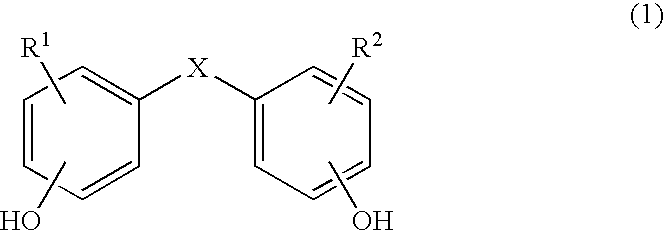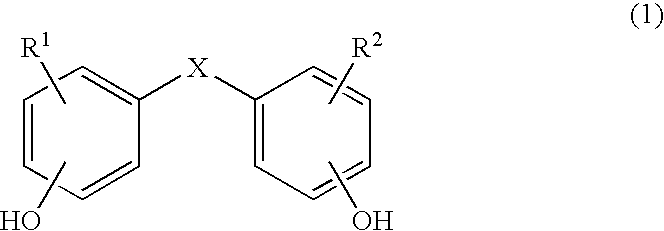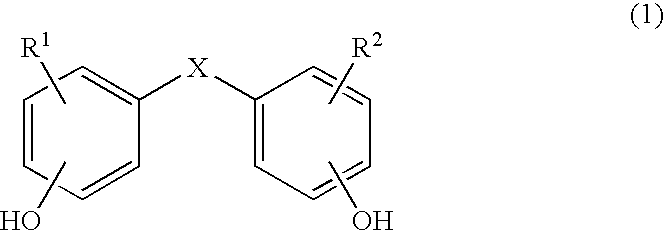Copolycarbonates having improved flowability
a technology of copolycarbonates and copolycarbonates, applied in the field of copolycarbonates, can solve the problems of unsatisfactory polycarbonates and copolycarbonates, and achieve the effect of improving flowability and process
- Summary
- Abstract
- Description
- Claims
- Application Information
AI Technical Summary
Benefits of technology
Problems solved by technology
Method used
Image
Examples
example 1
Synthesis of a copolycarbonate from bisphenol A / 4,4′-dihydroxydiphenyl ether (Molar Ratio 50:50)
[0129]
[0130]126 ml of methylene chloride are added to a solution, rendered inert with nitrogen, of 8.088 g (0.04 mol.) of 4,4′-dihydroxydiphenyl ether and 9.132 g (0.04 mol.) of bisphenol A as well as 7.04 g (0.176 mol.) of sodium hydroxide in 126 ml of water. In a one-step procedure, 0.42 g (0.0028 mol. or 3.5 mol. % relative to bisphenol) of p-tert.-butylphenol (BUP) are added as chain terminator. At a pH value of 14 and at room temperature, 11 ml (15.8 g, 0.16 mol.) of phosgene are added in the course of 10 minutes. In order to prevent the pH value from falling below 12, 25% sodium hydroxide solution was added during the phosgenation. When the phosgenation is complete, and after rinsing with nitrogen, 0.11 ml (0.0008 mol., 1 mol. % relative to bisphenol) of n-ethylpiperidine is added as catalyst, and stirring is then carried out for one hour. The aqueous phase is separated off, and the...
example 2
[0135]
Synthesis of a copolycarbonate from bisphenol A / 4,4′-dihydroxydiphenyl ether (Molar Ratio 95:5)
[0136]131 ml of methylene chloride are added to a solution, rendered inert with nitrogen, of 0.809 g (0.004 mol.) of 4,4′-dihydroxydiphenyl ether and 17.35 g (0.076 mol.) of bisphenol A as well as 7.04 g (0.176 mol.) of sodium hydroxide in 131 ml of water. In a one-step procedure, 0.36 g (0.0024 mol. or 3.0 mol. % relative to bisphenol) of p-tert.-butylphenol (BUP) are added as chain terminator. At a pH value of 14 and at room temperature, 11 ml (15.8 g, 0.16 mol.) of phosgene are added in the course of 10 minutes. In order to prevent the pH value from falling below 12, 25% sodium hydroxide solution was added during the phosgenation. When the phosgenation is complete, and after rinsing with nitrogen, 0.11 ml (0.0008 mol., 1 mol. % relative to bisphenol) of n-ethylpiperidine is added as catalyst, and stirring is then carried out for one hour. The aqueous phase is separated off, and th...
example 3
Synthesis of a copolycarbonate from bisphenol A / 4,4′-dihydroxydiphenyl ether (Molar Ratio 90:10)
[0141]
[0142]131 ml of methylene chloride are added to a solution, rendered inert with nitrogen, of 1.618 g (0.008 mol.) of 4,4′-dihydroxydiphenyl ether and 16.438 g (0.072 mol.) of bisphenol A as well as 7.04 g (0.176 mol.) of sodium hydroxide in 131 ml of water. In a one-step procedure, 0.36 g (0.0024 mol. or 3.0 mol. % relative to bisphenol) of p-tert.-butylphenol (BUP) are added as chain terminator. At a pH value of 14 and at room temperature, 11 ml (15.8 g, 0.16 mol.) of phosgene are added in the course of 10 minutes. In order to prevent the pH value from falling below 12, 25% sodium hydroxide solution was added during the phosgenation. When the phosgenation is complete, and after rinsing with nitrogen, 0.11 ml (0.0008 mol., 1 mol. % relative to bisphenol) of n-ethylpiperidine is added as catalyst, and stirring is then carried out for one hour. The aqueous phase is separated off, and ...
PUM
| Property | Measurement | Unit |
|---|---|---|
| molar ratio | aaaaa | aaaaa |
| temperature | aaaaa | aaaaa |
| temperature | aaaaa | aaaaa |
Abstract
Description
Claims
Application Information
 Login to View More
Login to View More - R&D
- Intellectual Property
- Life Sciences
- Materials
- Tech Scout
- Unparalleled Data Quality
- Higher Quality Content
- 60% Fewer Hallucinations
Browse by: Latest US Patents, China's latest patents, Technical Efficacy Thesaurus, Application Domain, Technology Topic, Popular Technical Reports.
© 2025 PatSnap. All rights reserved.Legal|Privacy policy|Modern Slavery Act Transparency Statement|Sitemap|About US| Contact US: help@patsnap.com



